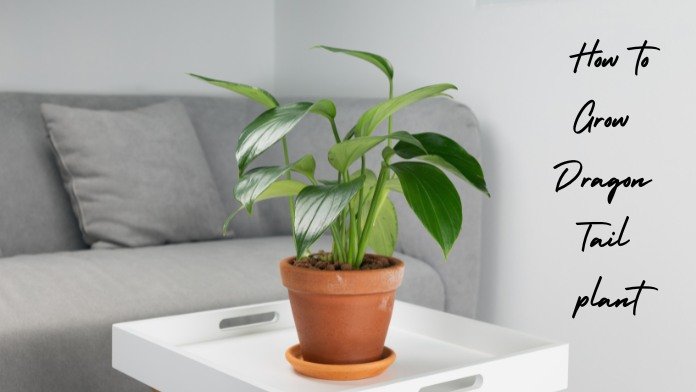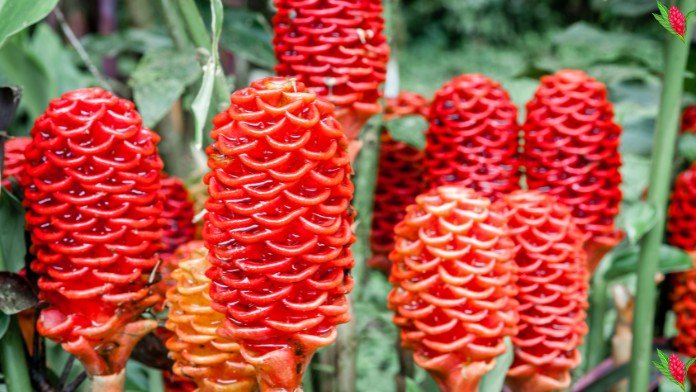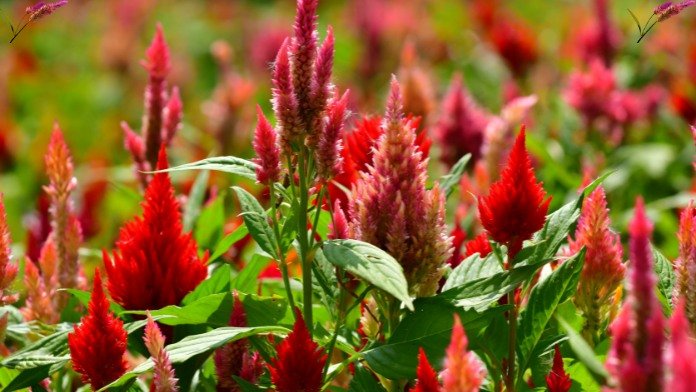
Dragon tail (Epipremnum pinatum) is a native plant you’ll want to add to your houseplant collection thanks to its attractive foliage. There are variegated and non-variegated leaf forms: variegated forms have whitish/green leaves, and non-variegated forms have shiny dark green leaves.
Both forms will grow elongated oval leaves when young, but as the plant matures, the older leaves will divide into three parts, like the tip of a dragon’s tail.
Epipremnum pinnatum, or dragon tail plant, often shortened to dragon plant, is an attractive houseplant. Store it inside to enhance your home interior.
Dragon plant flowers are rarely seen on trees, but it is not impossible for them to bloom. Now, we will know how to grow a dragon tail tree fast.
Alternate Name
Pothos, Tongavine centipede, Tonga plant, devil’s ivy.
Benefits of Having a Dragon Tail Plant
Air Purification
Dragontail plants are not just pretty faces; They are air purifier ninjas. They easily remove toxins from the inside, clean the air, and make the lungs happy.
Aesthetic Appeal
With foliage that would impress a designer, the dragon tail plant brings a unique style to any room. It’s like having a living piece of art without the high price tag.
Low Maintenance
If you forget the type of water plants, the dragon’s tail is behind you. It is drought-resistant and won’t attack you if you neglect it for a while.
Stress Reduction
Plants are nature’s stress balls, and dragontails are no exception. Being around can help relieve stress, like ice cream on a hot day.
Symbolism and Cultural Meaning
This plant is not just a pretty face but full of symbolism. Having one can bring an extra touch of luck to your life.
Health and Happiness
In addition to being beautiful to look at, the dragon’s tail plant is a health guru. It increases moisture and fights allergens, making it the silent guardian of your well-being.
Adaptability to Different Environments
Whether you live in a sun-drenched loft or a dimly lit studio, Dragon Tail fits the bill. It is the chameleon of the plant world and thrives in various conditions.
Emotional Connection
Caring for a live animal can be an ongoing experience. Dragon tail plants provide companionship without the need for walks or litter boxes.
Community and Sharing
Join the ranks of plant enthusiasts with your dragon tail. It’s a one-way ticket to a community that loves to share tips, cuttings, and plant-based joy.
How to Grow Dragon Tail
In nature, dragons grow as forest dwellers in tropical and subtropical climates, so they prefer warmth and humidity. However, it is very adaptable and will grow well indoors. Keep in medium to bright light and out of direct sunlight.
It will tolerate growth in low light, but growth will be slow. If the light is insufficient, the space between the leaves will be long, and sometimes the stem will be completely leafless. Clear signs that the plant needs to be moved to a brighter place.
Growth Conditions
- Aspect dragon’s tail prefers bright to medium indirect light indoors or outdoors.
- Soil Use Indoor Potting Mix, a premium potting mix specially formulated for indoor plants.
- Growing dragontail plants look excellent year-round, but growth will slow in winter.
Help establish roots by using water with a premium potting mix. Always remember to water regularly and sincerely, ensuring the water comes from the pot’s base. Allow the top 3-5 cm of potting mix to dry out between waterings.
Once established, plants tolerate long periods without water, especially if placed in a more fantastic location. Mist the leaves occasionally or group them with other houseplants to increase humidity. While this is not 100% necessary, your plant will appreciate it.
Top 5 Steps to Growing a Dragon Tail
- Dragon Tail prefers a location with bright, indirect light and high humidity.
- Use a premium mix, to get your plants off to the best possible start.
- Dragon tails can be climbed up a totem pole or hung over a pot’s side.
- Fertilize dragon tails with a houseplant fertilizer. Feed for indoor plants during spring and summer to encourage robust and healthy growth.
- Clean its large leaves occasionally to keep it dust-free and shiny.
General Care
- Watering The dragontail plant should be allowed to dry out completely between waterings.
- Store the pot in a plastic container and place it inside a container with a decorative lid unless you are growing outside. Give them something to hold on to, such as a totem pole or this large climbing plant.
- Feeding: You can use a liquid or granular fertilizer. Apply it Granular Controlled Release to indoor and outdoor plants and containers once per season. Combines a premium blend of nutrients, algae, and microbes for all potted plants. Supplement or apply liquid fertilizer.
- For a ready-to-use formula without mixing, apply a 1.25-liter pot of fertilizer. Activator for Indoor plant spray and soil. This easy-to-use liquid fertilizer and soil conditioner helps improve soil and feed plants. Apply every 2 to 4 weeks during the growing season and monthly as needed during the winter.
- Be careful. Rhaphidophora is generally problem-free and an excellent choice for beginners in the houseplant world. They will only give you trouble if you keep them wet all the time. Let them dry out between waterings, and you shouldn’t have any problems.
Grow Indoors or in Containers.
Choose a pot for your dragon tail about two times the size of the original nursery pot. Make sure it has drainage holes, or use a black plastic pot that sits inside a pot with a lid (pot without holes).
Carefully remove the dragon tail from the nursery pot and place it in the potting mix, filling in around the root ball with more potting. mixture
Water your new dragon tail well and pour off excess water from the pot or saucer (if using). Dragon tail plants are like moist soil that dries out between waterings and die quickly from root rot if they sit in water.
Outdoor Cultivation in Soil
If you live in a warm, snow-free climate, you can grow a dragon’s tail outdoors with dappled shade in a sheltered spot.
Remember that your dragon’s tail will naturally want to climb and may climb trees, bushes, or fences. If it grows in a direction you don’t like, you can prune it and use your cut pieces to make new plants.
Propagation
You may consider these tips for propagating dragon tail plants from stem:
- Cut the dredge stem to a decent size, but ensure it has at least 2 or 3 leaves.
- Cut sharply about 1.5 inches below a node.
- Remove the bottom sheet.
- Submerge the cutting in a jar of water and ensure the node is completely submerged.
- Periodically check this and refill the water level to keep the node in water.
- The first roots will be visible in 4 to 6 weeks.
- Remove the 12 cm-long dragontail Epipremnum roots from the water and plant them in a new container containing potting mix and soil.
It is possible to propagate dragon tail plants by stem cutting whenever possible. However, root formation is faster in warmer months.
Common Plant Pests and Diseases
Dragon trees are insect-free, except for aphids, which usually attack seedlings but not mature plants. The only disease to watch out for is fusarium leaf spot, a fungus that can be prevented with fungicides. To prevent leaf spots on houseplants, keep water away from the leaves when watering the plant.
Common Problems with Dragon Trees
Although a hardy plant, the dragon tree can show symptoms when in trouble. Look for the following symptoms that can usually be remedied.
New Leaves with Spots
If white or yellow spots appear on new leaves, especially around the tips, your plant has a disease called Dracaena marginata flaking.2 Temperature, humidity, and light must be adjusted to keep your plant happy.
Leaves Turn Yellow or Brown
When the leaves turn these colors, the plant may be absorbing too much fluoride in the water. The tips of the leaves may also turn yellow.
To fix this, try removing any soil that contains fluoride, such as perlite. Also, check the soil pH to make sure it is slightly acidic.
Leaves with Reddish Spots
If the leaves have reddish, brown, or tan spots, possibly with a yellow halo, you have leaf spot disease, which can be avoided with proper watering.
FAQ
Is the Dragon Tail Plant Lucky?
As a gift, the dragon tail plant is often associated with wishes of prosperity and happiness, much like lucky bamboo in Chinese culture.
What is Another Name for Dragon Tail?
Dragon’s tail plant is a common name for Epipremnum pinnatum, while Pothos is one of the common names for Epipremnum aureum.
Do Dragon Plants Need Sun?
Dracaena benefits from bright, indirect light. Too much sun can burn the leaves.
Why is My Dragon Tail Plant Dying?
Overwatering can lead to fungal problems or root rot. Try watering once a week, using enough water to start seeing drainage from the bottom of the pot.
Are Dragon Plants Suitable for Air?
According to research conducted by NASA and Dr. Bill Wolverton, Dracaena is one of the best air-purifying plants.
Do Dragon Trees Grow Fast?
The dragon tree grows very slowly, so don’t let its mature size of 25 to 50 feet deter you. This plant can take ten years to reach a height of 4 feet and 25 years to reach 25 feet.
RELATED POSTS
View all


